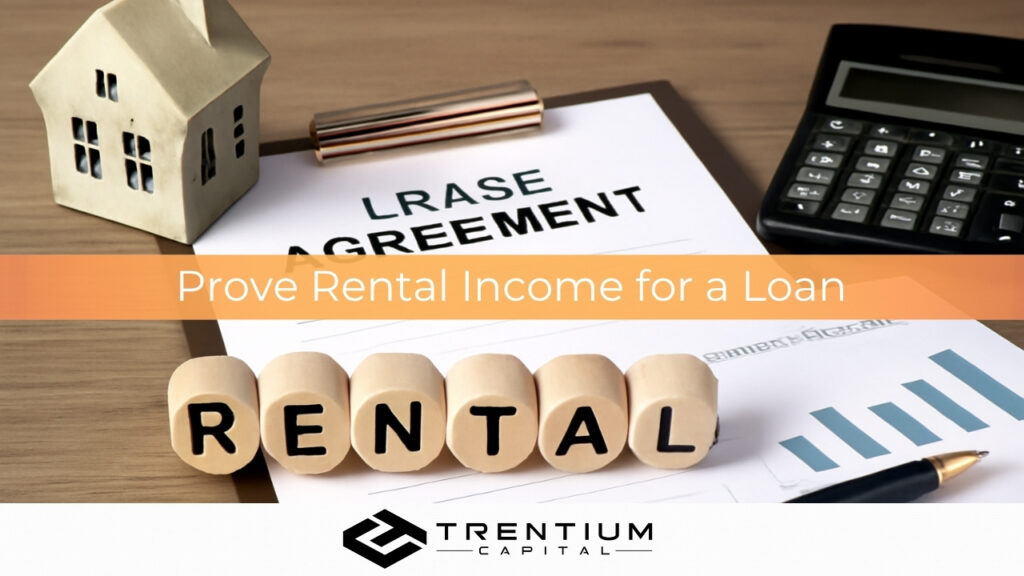Are you looking to qualify for a loan using your rental property income? Proving rental income can be one of the trickiest parts of securing financing, especially with private lenders.
Whether you’re trying to refinance, purchase another investment property, or use the income from your current property for a new loan, discussed by r/realestateinvesting. Understanding how this income is evaluated can make a difference.
This article’ll explain how to prove your rental income to secure that all-important loan. We’ll cover everything from required documents to strategies for increasing your chances of loan approval with private lenders like Trentium Capital.
Why Proving Rental Income is Essential for Loan Approval
When applying for a loan, especially from a private lender, you need to show that you have a reliable source of income. Rental income is often seen as one of the most stable forms of income, making it an attractive option for lenders. However, how this income is verified and what documentation is required can vary based on the lender’s specific guidelines.
The process typically involves demonstrating consistent rental income, showcasing detailed records, and meeting the lender’s income verification standards. Private lenders like Trentium Capital will use this information to evaluate your ability to repay the loan and your financial stability.
1. The Core Methods to Prove Rental Income for a Loan
Lenders, especially private lenders, rely on specific methods to verify rental income. Understanding these methods can help streamline your loan application process. Here’s a breakdown of the most commonly used ways to prove your income:
Lease Agreements
A signed lease agreement is the most basic and common form of proof. For properties in Ontario, private lenders require official Rental Tenancy Agreements (RTA), which are government-approved documents. These contracts clearly outline the rental terms and can be used to demonstrate a steady income stream from your tenants.
For regions that don’t require a government-specific agreement, a well-documented lease agreement with tenant signatures, terms, and payment amounts will generally suffice.
Market Rent Assessment
In cases where you don’t have a current tenant or are purchasing a new rental property, lenders will typically ask for an appraisal to estimate market rents. A property appraiser will assess how much similar properties in the area are renting for, and the lender will base your rental income on this data.
This method is beneficial when planning to lease a new property or rent out a portion of your home (e.g., a duplex or triplex).
Tax Returns (Schedule E for Rental Income)
Tax returns, particularly the Schedule E form in the U.S., are key documents lenders use to verify rental income. They provide a detailed breakdown of revenue earned from rental properties, allowing lenders to evaluate the property’s cash flow over time. Private lenders typically request these documents to ensure rental income is consistently reported and taxable.
Signed Tenant Acknowledgment Forms (TA)
Some private lenders will accept a tenant acknowledgment form (TA) as a simpler alternative. The tenant signs this document, acknowledging the lease terms and confirming rental payments. While not all lenders accept this form, proving rental income for smaller-scale landlords or those with fewer properties can be easy.
Bank Statements Showing Rental Deposits
Another easy and direct way to prove yo income is to provide bank statements showing regular deposits from tenants. This method ensures that the rental income is consistently received and deposited into your bank account, which can help lenders assess your financial reliability.
2. How Lenders Calculate Rental Income for Loan Qualification
Private lenders typically calculate rental income based on a percentage of the gross revenue received. However, they’ll adjust these figures for potential vacancies, maintenance, and repairs.
Typical Adjustments for Vacancies and Expenses
Lenders often apply a standard reduction to the gross income that comes from rent to cover possible vacancies, repairs, and maintenance costs. This reduction is around 20% to 25% of the rental income. For example, if your property generates $2,000 monthly rent, the lender may only consider $1,500–$1,600 as qualifying income.
How Much Rental Income Counts Towards Your Loan
Most private lenders will count 75%-80% of the gross rental income towards your qualifying income. However, you have a proven rental history. In that case, lenders count as much as 90-100% of your income, especially if you have been leasing the property for several years with well-maintained financial records.
Impact of Rental Income on Loan Approval and Terms
Your income can significantly impact your loan approval. A steady income stream improves your chances of getting a higher loan amount, better interest rates, and more favorable loan terms. Private lenders like Trentium Capital can evaluate your rental income as part of their overall assessment to determine how much risk they’re taking on.
3. Tips for Maximizing Your Rental Income for Loan Approval
If you’re looking to improve your chances of loan approval, there are several things you can do to ensure that your rental income works in your favor.
Keep Detailed Financial Records
Maintain detailed records of lease agreements, rent rolls, and bank statements showing rental income deposits. Accurate documentation will help lenders verify your income quickly and streamline the approval process.
Use Professional Property Management
Hiring a professional property management company can help maintain consistent rental income and manage tenant relationships. A property manager can also ensure that rent is collected on time and that the property is maintained correctly, which can be a positive indicator for lenders.
Stay on Top of Property Maintenance
Regular maintenance can help reduce vacancies and keep tenants satisfied, which helps secure your rental income. Upgrading or renovating the property to meet market demands can also justify higher rental rates, improving your financial standing when applying for a loan.
4. Can I Use Rental Income to Qualify for a Mortgage?
How Rental Income Helps in Mortgage Qualification
If you’re a property owner with rental income, it can be an essential asset when qualifying for a mortgage. Many lenders will consider your income part of your overall income to assess your ability to repay the loan. This can make a significant difference, especially for those applying for investment property mortgages or refinancing their current rental properties.
Loan Approval
Rental income is treated as supplemental income, which can improve your chances of loan approval by demonstrating financial stability. It can help bridge the gap between your income and the loan amount you need, especially for those who might not qualify based solely on traditional employment income.
How Much of My Rental Income Can I Use for Mortgage Qualification?
While rental income helps qualify for a mortgage, most lenders will not use the full amount. Typically, they will apply a percentage of this income towards your total income. This is done to account for potential vacancies, repairs, and maintenance costs.
- Standard Lender Guidelines: Most lenders will consider 75%-80% of your rental income when calculating your eligibility for a mortgage.
- Adjusted for Expenses: Lenders factor in vacancies and maintenance by reducing the gross rental income by 20%-25%. This ensures they protect themselves from income fluctuations due to tenant turnover or unexpected repairs.
FAQ’s
Do private lenders accept 100% of rental income for loan qualification?
It depends on your rental history and the lender. Private lenders may accept 75%-100% of rental income, especially if you have a proven track record of consistent payments and reliable tenants.
What documents do I need to prove rental income?
Standard documents include lease agreements, market rent assessments, tax returns, signed tenant acknowledgment forms, and bank statements showing rental deposits.
How much of my rental income can be used to qualify for a loan?
Typically, private lenders use 75%-80% of your rental income to qualify you for a loan, but this may vary depending on your property’s performance and financial history.
Can I use rental income from multiple properties to qualify for a loan?
Yes, you can use this income from multiple properties, but each property’s income will be evaluated separately based on the lender’s criteria and adjustments for vacancies and expenses.
How can I maximize my rental income for loan approval?
Keep detailed records, hire a professional property management company, maintain the property well, and consider upgrading it to meet market demand to justify higher rental rates.
Conclusion: Prove Your Rental Income and Secure Your Loan
Proving rental income for a loan is a crucial step in the lending process, and understanding how to present your rental income is key to improving your chances of approval. You can make the process much smoother by keeping detailed records, ensuring consistency in your rental income, and understanding your lender’s requirements.
Ready to take the next step in securing your loan?
Contact Trentium Capital today to discuss your rental income and explore the best loan options. With personalized loan solutions and a commitment to supporting real estate investors, we are here to help you achieve your financial goals.



